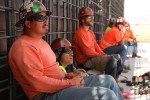Relieving pain manually
By EDMUND MEINHARDT
VIEW ON HEALTH
A man lies on a padded table in a small room. Another man, wearing jeans and a polo shirt, stands over the man and directs him to lie on his side, helping him to arrange his limbs just so -- one knee drawn up, arms folded across the chest. The man in the polo shirt leans over the man on the table, placing a knee on the man's hip and a hand under the man's upper torso. There is a quick movement and an audible series of popping sounds.
The man in the polo shirt is one of the more than 600 licensed chiropractors in the state of Nevada. About 20 million people in the United States see chiropractors every year, most of them for some sort of back pain, but chiropractors have been known to treat other problems including neck pain, pain in arm and leg joints and headaches. Chiropractors treat these problems with spinal adjustments -- sudden, forceful manipulations of the spine -- but they also use other treatments, including ultrasound, electrical muscle stimulation and exercise.
"We use (these treatments) to facilitate healing in the body," said John Strickland, DC, a chiropractor who practices at Low Back & Neck Pain Center in Las Vegas. "We're giving the body the means to heal itself."
Strickland said there are more than 50 different chiropractic techniques, but he concentrates on four. He uses the Thompson Drop, which employs a special adjusting table with a weighting mechanism to hold a patient in place before the adjustment motion. A segment of the table drops away from the patient as the force is applied. The Sacro-Occipital technique, abbreviated SOT, uses triangular blocks placed under a patient's pelvis to provide a stretch in the hips. Strickland says he uses this method a lot for pregnant women. He also uses an activator, which is a device that delivers a controlled mechanical tap to a joint, and a device called DRX that applies a traction-like force to joints.
"Every person's body is so unique and different," Strickland said. "There are such subtle differences with every body."
There are many differences between chiropractors, too. Some, like Strickland, concentrate mainly on direct manipulation of the spine and muscle tissue, electrical stimulation of muscle tissue, and stretching. Others employ techniques as diverse as ultrasound, acupuncture and nutritional counseling.
Gary Becker, DC, a chiropractor practicing at Chiropractic Plus Natural Health and Wellness in North Las Vegas, says he uses a broad-based approach that includes hot packs, soft tissue manipulation, therapeutic massage, ultrasound and traction.
"Most chiropractic offices use adjustments as the foundation of care," Becker said. "The other therapies are peripheral."
Larry Holt, DC, is a chiropractor and is also board-certified in addiction treatment. A native of Las Vegas, Holt said he was injured when he was 16 when he fell off a forklift.
"A chiropractor helped me get better," he said. "I became very interested in it. It was also one of the top 10 professions then."
Like virtually every other chiropractor, Holt performs adjustments, both with his hands and with instruments. He also uses ultrasound, electrical stimulation and auriculotherapy, also known as ear acupuncture. He says less than 5 percent of his practice is addiction treatment, but he expects that to grow. He helps with smoking, drinking and drug addiction, and favors a holistic approach to health.
"The body wants to be healthy," he said.
Chiropractic therapy has become commonplace, and the majority of insured workers in the United States have coverage for some kind of chiropractic treatment. Celebrities such as actor and director Mel Gibson have endorsed chiropractic treatment. Former champion bodybuilder and action film star Arnold Schwarzenegger, now Governor of California, is an enthusiastic advocate for chiropractic therapy and has spoken before the International Chiropractors Association.
But chiropractors were not always so respected. In fact, chiropractic and its practitioners have been the subjects of considerable controversy and conflict. The American Medical Association was notorious for its loathing and ridicule of chiropractors, labeling chiropractic "an unscientific cult" and declaring it unethical for physicians to associate with any "unscientific practitioner."
The chiropractors themselves felt it went beyond ridicule. They saw it as a concerted effort to contain and eliminate the chiropractic profession because it was a competitor siphoning off patients from mainstream medicine. In 1976, Chester Wilk and four other chiropractors sued the AMA, several health care associations and numerous physicians for violations of the Sherman Antitrust Act. In 1987, a judge found that the AMA had violated section 1 of the Sherman Antitrust Act and had engaged in an unlawful conspiracy in restraint of trade. The judge issued a permanent injunction against the AMA to prevent any such behavior in the future. She also explicitly stated that her ruling was not a declaration that chiropractic therapy was a valid and efficacious form of medicine.
The efficacy of chiropractic therapy is still the subject of debate, and it is still being extensively studied. According to the Mayo Clinic Web site, "Clinical trials indicate that chiropractic care is as safe and effective as conventional treatments -- which may include pain medication, rest or exercise. But that may not be saying much. Low back pain typically improves within a matter of weeks, even for people who seek no treatment at all."
Still, many people swear by chiropractic therapy. Andi Motola, a resident of North Las Vegas, has muscular dystrophy, a group of disorders that involve muscle weakness and loss of muscle tissue that gets worse over time. She had back trouble.
"I would just get so fatigued," Motola said. "I knew I was out of alignment."
Motola had seen a chiropractor before moving to the Las Vegas Valley from Prescott, Ariz., but hadn't found one here.
Her husband worked in the same building as Becker, and they became acquainted. Eventually Motola's husband persuaded her to go to Becker to get some relief from her pain, which was getting worse.
"He was such a good listener," Motola said. "During my first appointment, he must have spent about two and a half hours with me, getting my history, finding out about my diet, nutrition, vitamins, medications and all of it."
Motola said she was impressed with Becker's approach.
"A lot of doctors don't go for whole health," she said. "For Dr. Gary, it's really important. And he does this with everyone. He's interested in the whole person."
Becker, Holt and Strickland all agree that their patients bear a great deal of responsibility for their health and well-being. They all recommend an active lifestyle and say patients who exercise make the job easier.
"Movement is life," Holt said. "I like to tell my patients that we're born loose and die stiff. There aren't too many 80-year-olds who can stick their toes in their mouths."





















